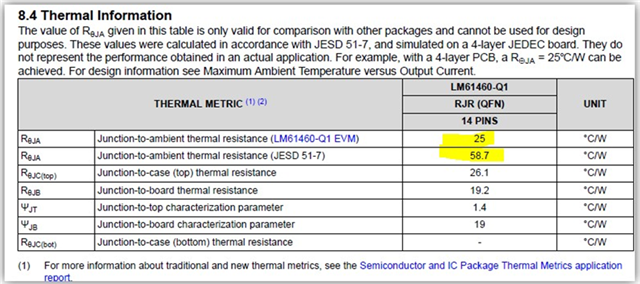Hi Team,
Can you help give a simple summary of what is so different about the JESD 51-7 theta ja testing vs our EVM theta ja to give such different thermal performances?

Thanks!
David
This thread has been locked.
If you have a related question, please click the "Ask a related question" button in the top right corner. The newly created question will be automatically linked to this question.
Hi Team,
Can you help give a simple summary of what is so different about the JESD 51-7 theta ja testing vs our EVM theta ja to give such different thermal performances?

Thanks!
David
Hi David,
According to the recommendations of JEDEC, the RθJA parameter is not suitable for estimating junction temperature in actual applications.
It is more suitable for comparing the thermal performance of different devices in the same package type, and it must be noted that the comparison is based on a similar PCB design.
The EVM value is an actual measured value and may be more applicable to customers who want to realistic thermal characteristic of the device following recommended EVM PCB layout. This value is more appropriate when trying to estimate the junction temperature of the evaluated device.
For more details on this, you can refer to the app notes below:
Regards,
Jimmy
Hi Jimmy,
would you mind giving a more simplified summary of what’s different about the JEDC board vs our EVM that makes it looks so bad in comparison? Like does the Jedec board not have the appropriate vias, layers, or are considerations of where heat can escape not accurate for HR packages?
Hi David,
The JEDEC board is a standardized board that does not account for heat escape and flow for HR / FCOL packages.
As such it is more realistic to use the EVM which implements recommended PCB layout to measure the top case temperature and extrapolate junction temperature. Also mentioned in the app note, the RthetaJA value may not be representative of the heat flow as it assumes all heat flows up and out of the device. Instead a more realistic thermal flow would have heat flowing out of the device as well as downwards towards the PCB.